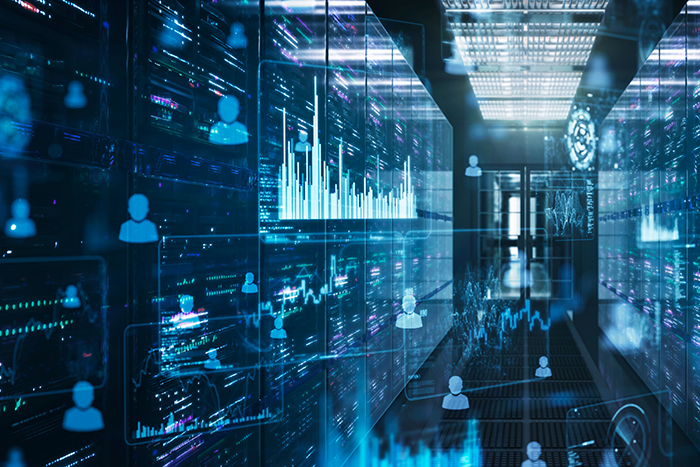Interviews / Energy and Raw Materials
31 October 2023
Digital pollution: the consequences of dematerialization in the era of the ecological transition

In the era of digitalization, digital pollution has become a major global concern. Indeed, digital technologies are currently responsible for around 3 to 4% of global greenhouse gas emissions. What are the main factors and actors driving digital pollution? What are the geopolitical and environmental stakes of digital technologies in the context of the ecological transition? As the race for new technologies (semiconductors, 5G, etc.) accelerates, is it feasible to implement the concept of digital sobriety in order to limit this pollution? The perspective of Guillaume Pitron, associate researcher at IRIS.
What are the main factors and actors behind digital pollution?
Digital pollution primarily results from the extraction of mineral resources used in the production of electronic equipment.
These devices are particularly complex to manufacture, and beyond the direct incorporation of metals and minerals, they require the indirect mobilization of other resources such as water – necessary for refining metals – and petroleum – essential for transporting components made in various countries worldwide. This is referred to as “Material Input per Service Unit” (MIPS), which is the ratio between the weight of the final product and the sum of all the resources involved in its manufacture. While the average MIPS for an object is around 30 to 1, it easily exceeds 1000 to 1 for digital tools due to their complexity, and the fact that many of the metals they contain are very diluted in the Earth’s crust, requiring the transformation of large volumes of rock. Some calculations suggest that the MIPS for an electronic chip, which contains around fifty resources, could be as high as 16,000 to 1, a record.
Thus, we face the paradox that surfing the “virtual” world of the internet creates a material impact among the highest. The “virtualization” of our lifestyles is, in fact, not the largest effort in materializing history?
Another form of pollution stemming from digital technology is atmospheric: CO2 emissions, as electricity is required to run the mines and keep data centers constantly operational. This electricity often comes from hydrocarbons. It is important to note that CO2 emissions represent only a small fraction of this overall pollution. We tend to focus our environmental efforts solely on this criterion, but it hides other significant impacts such as water and soil pollution, ocean acidification, and biodiversity loss, which are just as important.
What are the geopolitical and environmental stakes of digital technology in the context of the ecological transition?
Digital technology is easily presented as a natural ally in the fight against climate change. For instance, sending an email instead of a letter saves paper, ink, and the postal delivery system.
Linked to the energy transition, digital technology is also an excellent tool for managing electrical grids. Transitioning from coal to solar energy brings the issue of intermittency in electricity production, since the sun doesn’t shine all day. Digital technologies help to match supply and demand in real-time, minimizing resource waste.
For 20 years, everything digital seemed to have the dual benefit of stimulating the modern economy while being good for the planet, with the “smart city” often being seen as the ambassador of this new, happy age.
However, the digital reality unfolding before us is in no way compatible with the Paris Agreement. This technology is not inherently bad, but it depends on how it is used. Today, we are actors in a huge consumption of this resource, the internet. Cryptocurrencies (whose true economic, social, and political value remains unclear), 5G (whose economic benefits remain poorly understood), and generative artificial intelligence (AI) are just the latest examples of extraordinary and fascinating innovations that we are not truly utilizing to regenerate ecosystems or foster solidarity.
Unless there’s a massive awakening, especially among the “Greta generation,” who are heavy consumers of these tools, it’s hard to imagine how digital technology can serve the cause it often claims to support.
As the race for new technologies (semiconductors, 5G, etc.) continues to accelerate, is it feasible to apply the concept of digital sobriety to limit this pollution?
This rather nice term raises many questions. In fact, we see that only a tiny percentage of internet users are committed to using this resource more soberly, for example by refusing to change their mobile phone every 18 months or by getting more involved in “Makers” networks and “Fablabs,” where they repair, reuse, and recycle. However, this reality clashes with a much stronger and reverse dynamic. Semiconductors and 5G are technologies all converging toward one goal: data production, the new fuel for the ever-present engines of history that drive the pursuit of power, prestige, influence, and prosperity.
If the French government has embarked on the deployment of 5G, it’s not just because the technology will generate growth, but because France (or any other European state) cannot afford to be overtaken by the United States and China in this field. It is a matter of technological sovereignty and geopolitical standing.
Exploring the metaverse and developing generative AI largely reflects the same fear of being surpassed by rival powers who understand that whoever governs cyberspace will hold part of the keys to the 21st century. In this context, the environmental dimension of digital technologies is completely overlooked.
It seems that states and companies will continue, in the future, to act as they have up to now: counterbalancing our exponential data consumption with optimization measures. In response to the accumulation of generative AIs, there will be calls for research and innovation to “do more with less.” Tomorrow, we are promised that data will be stored in plant DNA and in data centers placed in orbit. No one can predict when these ideas will become reality, but what is certain is that they will drive our economies.

